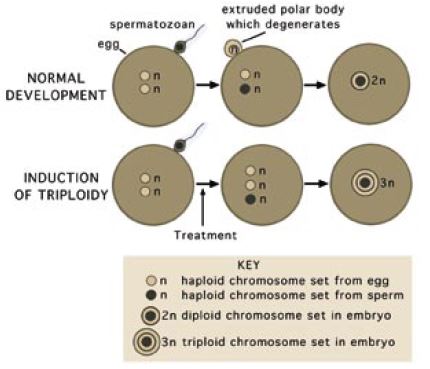7.1.1 Polyploidy
One area of bivalve genetics that has been investigated and is now widely practiced is polyploidy, particularly the production of animals that are triploids (3n). Although triploid scallops, clams and mussels have been produced, most work has centred on the production of triploid oysters and in particular triploid Pacific oysters.
Interest in developing the technology for the production of triploid oysters on the Pacific coast of North America arose for two reasons. First there was the desire by industry to have an oyster that was of good eating quality throughout the year in order to maintain and extend the marketing season. Gonads of Pacific oysters can occupy up to 50% of the weight of the soft body parts. When glycogen is converted into gametes in the spring the oysters become unpalatable and after spawning the soft parts become emaciated and watery. Both states render the product unsuitable for marketing. Secondly, if spawning could be avoided there was possibility of reducing mortalities due to the so called “summer disease” which is believed to result in part from physiological stress at the time of breeding. If transformation of glycogen into gametes can be prevented by growing triploid oysters, it is conceivable that mortalities could be significantly reduced.
Triploids are produced by preventing the egg undergoing meiosis so that it remains in the diploid (2n) state. When such an egg is fertilized by sperm in the 1n (haploid) stage the result is a triploid (Figure 109).
Bivalve eggs can be prevented from undergoing meiosis to the 1n state by subjecting them to pressure, heat or chemicals. Originally most triploids were produced by treating eggs with a chemical, cytochalasin B. Eggs were stripped from females and fertilized with sperm. Gametes were kept separate until ready to fertilize so that the process could be closely controlled. After the first polar body appeared, the fertilized eggs were treated with cytochalasin B preventing the eggs from undergoing meiosis. Thus, the eggs remained in the 2n state and with the contribution of the male chromosome set, the result was a triploid embryo. The technique was perfected over time so that success rate in producing triploids was about 90%.
There are two problems in producing triploids by this method. The first is that it does not produce 100% triploids. The second is that the chemical cytochalasin B is carcinogenic and although it is only used in the fertilization of the animals and hence poses little possibility of carrying over a toxic effect, there has been concern of repercussions from the public. The chemical method to produce triploid oysters is no longer generally used in hatcheries.

Figure 109: Representation of the process of triploidy induction.
The method now used by some hatcheries is heat shock. Fertilized eggs, normally held at 25°C, are suddenly subjected to a temperature of 32°C for two minutes and then are returned to 25°C. The temperature shock is applied after the emission of the first polar body, about twenty minutes after fertilization. Again this method has been perfected and the success rate in producing triploids is about the same as with the chemical method, i.e. averaging about 90%.
Both the chemical and heat shock methods are effective but the main disadvantage of both is that 100% triploids are rarely, if ever, achieved. A method was needed that could consistently produce 100% triploids with each breeding.
Research in both Europe and the United States has led to development of methods to produce tetraploid (4n) oysters. To date only male tetraploids have been produced and the method is proprietary so few details of the methods can be given. Arrangements can however be made with companies that produce tetraploids to obtain them for use in hatcheries as broodstock. When mated with diploid oysters they always produce triploids. The method is effective and will probably be employed widely by the hatchery and growout industry as tetraploids become more readily available.
On the Pacific coast of the United States a major portion of the production of juvenile Pacific oysters in hatcheries is now triploids.